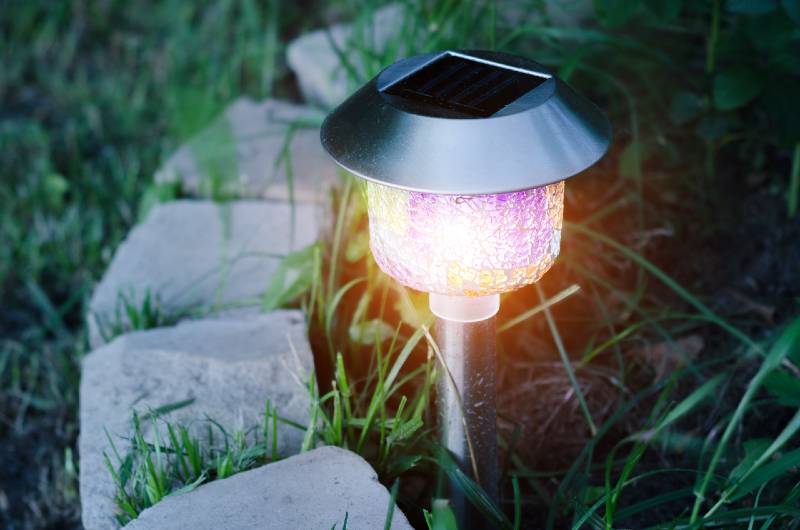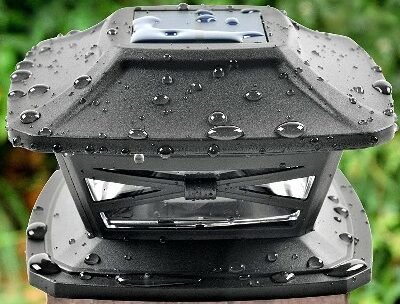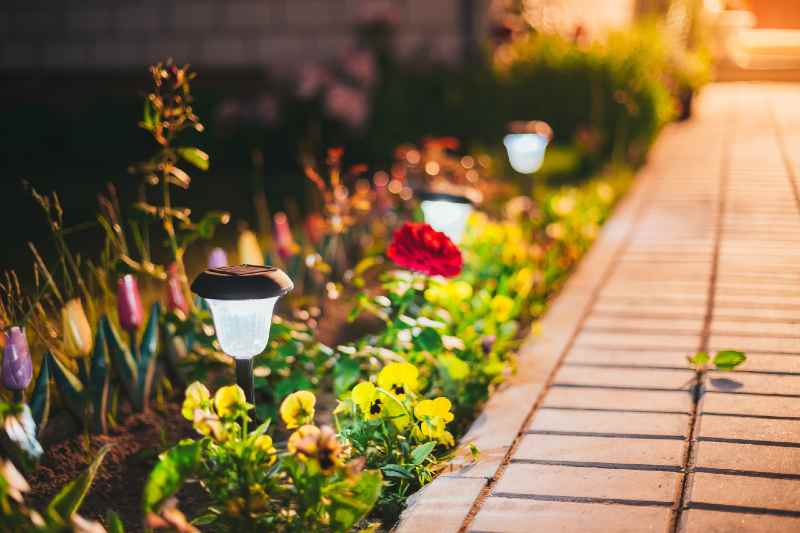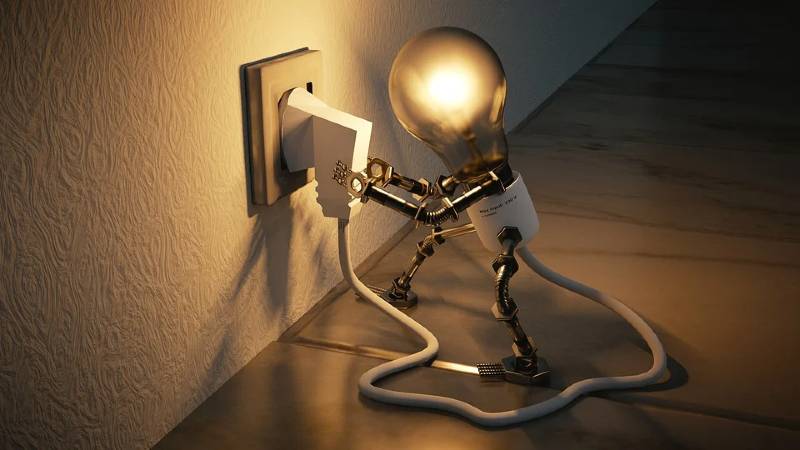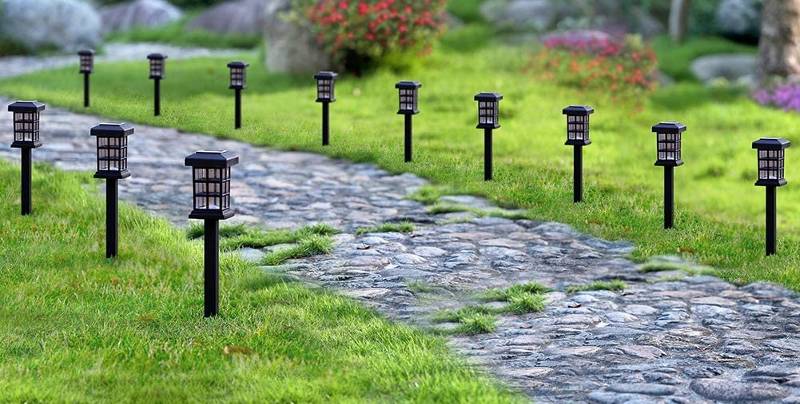Are your solar garden lights not as bright as you’d like?
You’re not alone; it’s a common problem.
The good news is that there are easy fixes.
Sometimes all it takes is a quick clean or a small tweak, while other times, upgrading to better-quality lights can do the trick.
I’ve tried out different ways to boost their brightness, and in this guide, I’ll share the best tips to make your solar garden lights brighter.
So, let’s get started on lighting up your outdoor space perfectly!
Key Takeaways
- Solar garden lights convert sunlight into electricity using photovoltaic cells, storing the energy in batteries, and using it to power LEDs at night.
- Investing in high-quality, well-sealed lights with tempered glass covers can significantly improve brightness and longevity.
- Optimal positioning in sunny spots and regular cleaning of the solar panels and light casings are essential for maximum efficiency.
- Replacing hazy solar cell covers and inspecting LED bulbs for wear can help maintain brightness.
- Regularly check and clean battery terminals to ensure good connections and replace old batteries to maintain optimal performance.
How Do Solar Garden Lights Work?
Solar garden lights work by soaking up the sun’s rays to light up your garden or walkway without needing to plug into your home’s power.
This process starts with something called a photovoltaic cell, or simply, a solar cell.
It’s a neat little component that catches sunlight and transforms it into electricity.
Here’s how it goes: the solar cell contains a special material that gets excited when hit by sunlight, pushing out tiny particles called electrons.
These electrons rush around to create an electrical current.
This current then flows into a battery where it’s stored as energy until it’s needed.
As the evening rolls in and it starts to get dark, a clever little gadget called a photoresistor kicks in.
This gadget is super sensitive to light and controls when the lights turn on and off.
During the day, it keeps the electricity safely in the battery, but at night, it lets the electricity flow, lighting up the LED bulb in the solar light.
The LED glows using the energy from the battery, giving you light all night until the sun comes back up.
The light doesn’t need any switches because the photoresistor does all the work, turning your lights on when it gets dark and off when it’s light again.
Besides these cool components, your solar light also has wires and a circuit board that helps connect everything inside a tough, weatherproof case.
This means your lights can stay outside in the rain or shine without any fuss.
How to Enhance the Brightness of Your Solar Garden Lights?
1. Invest More Initially
You might always hear people say, “You get what you pay for,” and it’s true, especially when it comes to solar garden lights.
If you shell out a bit more cash for quality lights from reputable brands, you’ll see a big difference in how well they light up your yard and how long they last.
These better-quality lights tend to be brighter and need less fuss over maintenance, which makes them worth the extra pennies.
When you’re on the hunt for these lights, pick ones that feel sturdy and are well-sealed.
This is key because it stops water and dirt from messing them up, keeping them bright and functional for longer.
Also, take a close look at what the covers on the solar cells are made of.
Tempered glass is a winner here because it lets more sunlight in and doesn’t get foggy as time goes by, unlike plastic.
2. Position Your Solar Garden Lights Optimally
Of course, you know solar lights need a good dose of sunshine to work their best at night.
So, getting the spot right for placing your solar garden lights is super important if you want them to be as bright as possible.
Even though these lights can still soak up some energy on cloudy or rainy days, they thrive on clear, sunny days.
Take a walk around your garden and see if there are any spots where trees, plants, or parts of your house might keep the sun away from your lights.
Remember, in the northern hemisphere, the sun hangs out mostly in the southern sky, so ideally, you’d place your lights on the southern side of any obstacles.
Related article: How To Install Solar Lights?
3. Keep Your Solar Lights Clean
Just like windows can get smeared and grimy, the clear covers on your solar lights can collect a lot of dust and debris.
This grime can get in the way of the sunlight they need to suck up during the day.
Whether these covers are made of glass or plastic (and keep in mind, plastic can get scratched and cloudy after a while), they all need a good cleaning regularly to keep them working well.
Think of it this way: the solar cell in your light is like a team, where each layer has a job to help trap as much sunlight as possible.
There’s even a special antireflective layer just under the glass that stops the sunlight from bouncing off.
So, if the top layer—the one that faces all the weather and dust—is dirty, it’s going to block that teamwork, right?
Now, even though a good rain shower can do a decent job of cleaning them off, it’s always better to give them a bit of a hand wash now and again.
This is especially true if it hasn’t rained in a while or if your lights are placed under something that keeps them dry, like a tree or an overhang.
Just grab a soft cloth or sponge and some gentle soap—nothing too harsh that might scratch up the cover or mess up that antireflective coating.
A gentle wipe-down every so often will keep them catching and converting sunlight like champs, making sure they light up bright every night.
4. Replace Hazy Solar Cell Covers
Sometimes, the problem is right on the surface: cloudy covers over the solar cells.
These plastic covers can get foggy or scratched up over time, which stops the sun’s rays from powering up your lights properly.
That means by the time evening rolls around, they might not have enough juice to light up your garden well.
But here’s some good news—if these covers are replaceable, you’re just a quick fix away from brighter lights.
All you need to do is snap off the old, cloudy cover and clip on a fresh one.
Related article: How To make Solar Lights brighter than the other solar lights
5. Clean the Solar Light Casings
Just like the solar cell covers, these casings—whether they’re made of glass or plastic—can get dirty over time.
Dirt, stains, and grime on the casings can block the light from shining through effectively, making your lights look dimmer than they are.
So, all you need is a soft sponge and some mild detergent.
Gently wipe down the casings to remove any dirt or marks.
Avoid using harsh chemicals or abrasive materials that could scratch the surface or damage the casing.
Regular cleaning not only helps your lights shine brighter but also extends their overall lifespan by maintaining the components in good condition.
6. Inspect the LED Lights
LEDs (light-emitting diodes) are the stars of the solar lighting world because they’re incredibly efficient and can last for ages—think thousands of hours of bright light.
But even these tough little lights have their limits and will eventually wear out.
Unlike other bulbs that dim gradually, LEDs tend to keep their brightness right up until they don’t.
So, if you find that one of your solar lights isn’t turning on anymore, the LED might have finally called it quits.
If your light is designed with replaceable LEDs, swapping in a new bulb is a breeze and can bring your garden light back to life in no time.
However, if the unit is sealed and you can’t just change the bulb, you’ll need to replace the entire light fixture.
Related article: Can I Use Higher mAh Battery In Solar Lights?
7. Examine the Battery and Connection Terminals
Batteries in solar lights don’t last forever, and when they start to fade, your lights might not shine as brightly.
So, you need to check your batteries now and then for any signs of trouble, like damage or that pesky white corrosion you sometimes see on the terminals—it looks a bit like powdery residue.
Before you start cleaning, pop on some goggles for safety—better safe than sorry, right?
If you spot any of that white stuff, grab a cloth soaked in a bit of vinegar and gently wipe the terminals clean.
This can kick things back into gear and improve the battery’s performance.
If a clean-up doesn’t do the trick and your lights are still dim, it might be time for a battery update.
Just remember to dispose of the old batteries properly to keep things green and safe.
FAQs
How to Make Solar Garden Lights Brighter?
To make solar garden lights brighter, invest in high-quality lights, position them optimally, and keep them clean to ensure maximum sunlight absorption.
Why Are My Solar Lights Not So Bright?
Your solar lights are not so bright because dirty solar panels, aging batteries, or obstructions blocking sunlight.
How Can I Boost My Solar Lights?
To boost your solar lights, clean the solar panels, replace hazy covers, and ensure they receive plenty of direct sunlight.
Why Are My Solar Garden Lights Dim?
Your solar garden lights are dim due to cloudy solar cell covers, worn-out batteries, or dirty light casings.
Conclusion
As promised, we’ve shared the top tips to make your solar garden lights brighter.
From buying better-quality lights to keeping them clean and positioning them just right, these tips can make a difference.
A quick pro tip: regularly check your solar panels with a multimeter to see if they’re getting the right voltage.
This can help you spot any problems with how well they’re converting sunlight into energy.
If you have any questions or need more help with your solar lights, don’t hesitate to reach out!
Join our solar microdosing newsletter and get bite-sized, easy-to-understand insights into the world of solar energy.
From how solar panels work to building your own DIY solar system, we’ve got you covered.



